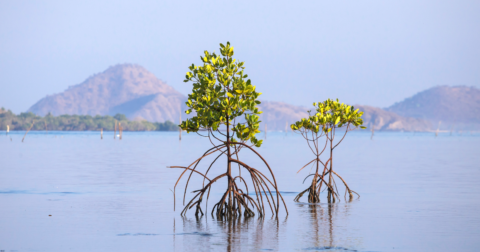Southwest Wisconsin Dairy Operation Linked to Spill Affecting Eight Miles of Trout Waters
Climate•4 min read
Explainer
On a per capita basis, mangroves capture four times more carbon than the Amazon.


Words by Seth Millstein
Mangroves are among the most important ecosystems on the planet. Though unassuming in appearance, these collections of trees and shrubs are crucial sources of biodiversity across the planet, and play a vital role in protecting human populations from natural disasters. But certain human activities like shrimp farming put mangroves at risk, threatening both the marine life they support, and the humans who rely on them for safety.
A mangrove is a subset of trees and shrubs that grow in coastal saltwater. They’re found in tropical and subtropical latitudes around the world, and are notable as the only trees that can tolerate saltwater. Mangroves grow long roots that form nest-like structures; in some species, the roots grow upwards and absorb oxygen while the lower portion of the mangrove remains submerged.
The term “mangrove” is used somewhat loosely; while there are technically only 54 “true” species of mangrove, some scientists also include so-called “mangrove associates” — species that grow in or near mangrove forests — in that tally as well. If one uses that more inclusive definition of the word, the number of mangrove species grows to well over 80.
In addition, some people use the term “mangrove” to refer strictly to the species of trees and shrubs that are considered mangroves, while others use the word to refer more broadly to mangrove forests.
A mangrove forest is a collection of mangroves that grow alongside one another and, in doing so, form an ecosystem for other nearby plants and animals. You can find mangrove forests on every continent except Europe and Antarctica, and they collectively cover between 53,000 and 73,000 square miles of the planet. Most mangrove forests are several miles thick, but some can grow to be much larger.
Mangroves are found all over the tropical and subtropical areas of the world. Indonesia is the country with the most mangroves. Brazil, Malaysia, Papua New Guinea and Venezuela also have significant mangrove forests.
Mangroves also play a crucial role in fighting climate change. As part of their natural development, mangroves capture carbon dioxide from the air and use it to grow branches and leaves. When those branches and leaves die, they fall into the water and are buried in mud, taking the carbon that they contain with them. This process is known as carbon burial, and it’s an essential and organic tool for reducing greenhouse gasses.
Mangroves are considered one of the most effective of all ecosystems, aquatic and terrestrial, at sequestering carbon from the atmosphere. On a per capita basis, they capture four times more carbon than the Amazon, and although they account for less than two percent of marine environments, they’re responsible for 10-15 percent of carbon burial around the world.
Mangroves and mangrove forests play an essential role in maintaining and balancing the planet’s ecosystem, largely through the extraordinary biodiversity that they create and promote. Mangrove trees themselves are but a small fraction of the species that live and thrive in mangrove forests; countless other plants and animals rely on mangroves to survive, often in novel and inventive ways.
Many fish, for instance, use mangroves’ complex underwater root systems as protection against predators, as they’re thick and difficult for larger creatures to swim through. Mangrove branches are such an effective sanctuary that some species, like the rainbow parrot fish and Goliath grouper, live their entire young lives there until reaching a certain age. Certain species of rays, sharks and sea turtles also take advantage of mangrove roots in this way.
Meanwhile, mudskippers thrive in the warm waters of mangroves, while mud lobsters dig around for food in the mud. This digging creates large burrows in the mud, and — in a good illustration of ecological interdependence — these burrows make excellent homes for snakes and mangrove saplings.
Above ground, countless birds rely on mangrove leaves as a food source, and some species live exclusively in mangrove forests. The proboscis monkeys of Borneo, for instance, are only found in mangrove swamps. Certain anole lizards live in mangrove trees, feeding on the insects that also live there, while the critically endangered sifaka lemur lives only in the mangroves of Madagascar. Frogs, snakes, snails, tigers, turtles, alligators and even cats — that’s right, cats — are but a few of the other species that live and thrive in mangroves.
A 2021 report by the Global Mangrove Alliance found that 341 threatened species are dependent on mangroves for their survival. In 2008, scientists discovered the critically endangered Hawksbill sea turtle, which was previously believed to dwell only in coral reefs, in mangroves in the Eastern Pacific. A 2016 survey identified 23 different species of lemurs, who are some of the most endangered animals on Earth, living in mangroves.
In the broadest sense, mangroves make the world more biodiverse, and biodiversity is essential to our existence as a species. Birds and bees pollinate our crops, giving us food to eat; plants and microbes facilitate the Earth’s natural water filtration cycle, giving us clean water to drink; and trees oxygenate the air around us, ensuring that we can breathe it. Humanity as a species is dependent on healthy ecosystems with sufficient biodiversity.
Mangroves also serve as protection from natural disasters; their thick foliage reduces the force of winds and waves that run into them, which helps minimize damage to coastal communities from strong storms. During extreme weather events like tsunamis, this protection can be the difference between life and death.
In the aftermath of the 2004 Indian Ocean Earthquake and Tsunami, for example, a comparison of two Sri Lankan villages revealed that the one protected by mangroves only suffered two deaths, while an exposed village without them incurred 6,000 deaths. The trauma of this catastrophe spurred the cultivation and development of mangroves in Aceh province Indonesia, where citizens are developing mangroves to use as a natural barrier against future disasters.
That’s not the only way mangroves help coastal communities. They also provide crucial natural resources, such as fruit, honey and numerous medicines. Additionally, mangroves have been shown to improve the quality of drinking water for nearby communities, as they naturally serve as a filter of salt and other undesirable elements.
Since 1980, between 20 and 35 percent of all mangroves have been destroyed. There are several reasons for this, the biggest one being the shrimp industry.
Between 1988 and 2008, global shrimp farming quintupled, with expansions mainly taking place in China, Thailand and Indonesia. Over five million tons of shrimp were produced around the world in 2023, with five countries — Ecuador, China, India, Vietnam and Indonesia — responsible for 74 percent of that production.
Unfortunately, this massive expansion has wrought havoc on mangrove forests, which are often degraded or destroyed as a result of shrimp farmers’ efforts. According to Seafood Sustainability, an estimated 238,319 hectares of mangrove across 17 countries have been cleared to make way for shrimp farms. Given the important role mangroves play in trapping carbon, this has been disastrous for the environment. Between 30 and 122 million tons of carbon were released into the air due to mangrove clearing between 2000 and 2015, a 2018 study found.
Even mangroves that aren’t completely destroyed by shrimp farms are still damaged and degraded by them. In order to provide water to their shrimp, farmers will often dig channels that divert the natural flow of fresh and saltwater away from mangroves and into shrimp ponds. This is dangerous for mangrove forests, as the reduction in saltwater makes it harder for mangrove saplings to be dispersed, and the lack of freshwater deprives mangrove trees of their life source. Shrimp farms are also major pollutants, thanks to the massive amounts of pesticides, antibiotics and other chemicals that are pumped into shrimp ponds. Much of the time, this pollution ends up in mangroves.
Shrimp farming is just one of many human threats to mangrove forests. They’re also destroyed to clear space for various forms of agricultural development, such as rice patty farms and palm oil plantations, or are chopped down for charcoal and timber.
The death of coral reefs due to rising water temperatures, a product of climate change, can also hurt mangroves; reefs regulate the strength of waves, and with those reefs disappearing, stronger waves are hitting mangroves, often washing away important nutrients and preventing saplings from taking root.
As a consumer, you can limit your contribution to mangrove destruction by eating less shrimp, or even eliminating it from your diet entirely. If you live in an area with mangroves, you can also investigate what local organizations, government branches or charities are working to preserve them, and volunteer your time or resources.
Another way to help is simply to visit mangrove forests, as this supports ecotourism industries that benefit from the beauty of mangroves and, as such, incentivizes those industries to continue preserving them.
Mangroves only occupy around 0.1 percent of the globe’s surface area, but are disproportionately crucial to the global health of plant, animal and human life. They protect coastal communities from natural disasters and erosion, sequester and store carbon more effectively than any other biome, and create vibrant and unique ecosystems that support thousands of different species. They benefit plants, animals, humans and the planet in many ways, and if we want to continue reaping these benefits, we would be wise to prioritize their health.